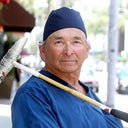Hi! I had a complicated Rhinoplasty revision a year ago. My surgeon is in LA so I have been unable to go back and see him. My nose still looks swollen and this fluctuates depending on the time of day and heat.
Frequently, my nose goes bright pink and swells up, at least once a day. It will stay like this for a while then go back to normal. There are no foreign objects in my nose. I also often find it very difficult to breathe through my nose, this also fluctuates.
My surgeon has recomended a steroid injection. Do these still work after a year to reduce swelling? I also have bluish and red discoloration on the tip after the second surgery, will this ever go away? So many questions! I don't have many pics on this computer, the one I have uploaded does not show discolouration as i have make-up on. Thanks very much.
Answers (5)
From board-certified doctors and trusted medical professionals
Dr. Sam Rizk, MD

Dr. Sam Rizk, MD
Board Certified Facial Plastic Surgeon
Answer
Dr. Anil R. Shah, MD

Dr. Anil R. Shah, MD
Board Certified Facial Plastic Surgeon
Answer
Dr. Toby Mayer, MD

Dr. Toby Mayer, MD
Board Certified Facial Plastic Surgeon
Answer
Dr. William Portuese, MD
Dr. William Portuese, MD
Board Certified Facial Plastic Surgeon
Answer
Dr. Jason Litner, MD
Dr. Jason Litner, MD
Board Certified Facial Plastic Surgeon
Answer
More Rhinoplasty Questions
See all Rhinoplasty Q&AWE SEND PRETTY
EMAILS
What’s trending? Who’s turning heads? Which TikTok myths need busting? We’ve got you. No fluff, no gatekeeping—just real talk. Get our free, unfiltered newsletter.